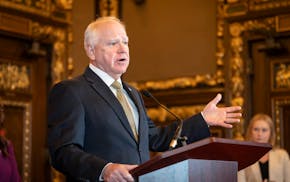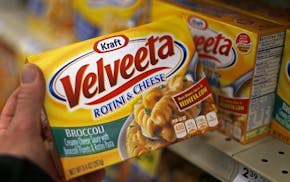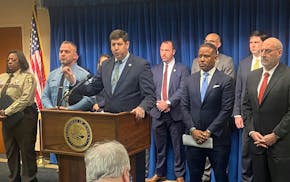BATTLE LAKE, MINN. – As the sun rose over West Battle Lake one morning last week, the temperature read minus 24 outside the Shoreline Restaurant, a restaurant/bowling alley/institution in this Otter Tail County town since 1949.
The cold bit hard, the most trying part of life on the windswept prairies of west-central Minnesota. Cold like this makes most Minnesota resort towns hibernate, roll up their sidewalks and wait until tourists return for the May fishing opener.
Inside the restaurant, though, 14 townies sipped coffee together, celebrating the town's newfound winter successes and plotting for more. A candlelight walk at adjacent Glendalough State Park the previous weekend brought out 400 people.
A conscious effort from restaurant owners to stay open through winter — Battle Lake, population 857, has a dozen restaurants in or near town, with the majority now open year-round — has turned the town into a regional foodie destination even in frigid months.
And an annual ice-fishing derby this weekend will bring more than 1,000 people to the 5,600-acre lake. They'll fish for modest cash prizes ($100 for the largest angled walleye) and impressive raffle prizes (like a $30,000 fish house). The event is purposely family-friendly.
"That's our goal — our town needs families and kids," said former Mayor Gene Kelm.
Even a huge, destabilizing ice heave can't keep Battle Lake down. The ice-fishing derby was simply moved to the other side of the lake.
"We came up in winter once and we drove through Battle Lake around 2000, and it was just, wow — nobody here," said Brian Wyneken, who moved to his longtime cabin here after retiring. "The only restaurant had a 10-year-old waiting tables. We were the only people in there. We thought, 'This place really goes pooey in the winter.' Now? It's dramatically different."
Battle Lake likes to call itself the "Heart of 1,000 Lakes," a nod to its central location in the Minnesota county boasting more lakes than any other. Summer lake life is one of the things that most define Minnesota — Kelm guesses the town's population increases to 8,000 in summer — but Otter Tail County's lakes are not top of mind when Minnesotans hunker down for winter.
But aided by the work-from-home (or work-from-cabin) life of COVID, Battle Lake has flipped its wintertime narrative.
"After COVID, we saw a big increase in traffic, and it just stayed rolling all the way through the winter," said Mike Naumann, who owns the Shoreline Restaurant and puts an ice bar on the frozen lake, which he moved to the parking lot this winter courtesy of the ice heave.
"There's just more people around. I have some young bowlers in our league who moved up here because they wanted to live rural and get out of the city. It's the appeal of the niceties of a small town."
This is not to say Battle Lake is suddenly a winter tourist destination on the scale of Lutsen Mountain and Giants Ridge for downhill skiing, or the Gunflint Trail for Nordic skiing, or Mille Lacs and Lake of the Woods for ice fishing.
Battle Lake's winter ambitions are more modest: To make sure its tourist-driven economy doesn't settle down for a long winter's nap.
This winter push was built atop of the quintessential resort town's overall momentum.
"In 2008, Battle Lake was dying," said Dan Malmstrom, a native who for decades worked in tech in Fargo while living in Battle Lake and has become one of its biggest boosters. "The storefronts were all for sale. They were destitute and dilapidated. We all wanted to build a community."
Town leaders came up with a vision: Instead of focusing on job creation, focus on making the town attractive to families. Business would follow.
The adjacent Glendalough State Park was struggling; in 2010, only 40,000 people visited, and it was looking at reduced state funding. A new 12-mile trail system opened in 2014 and connected Battle Lake to the park and its five lakes. Now a cycling destination, the park attracts 125,000 annually.
Town leaders see the trails and the trail center, where you can rent snowshoes and cross-country skis, as the spark to the town's overall growth, pointing to more than 30 new businesses that have started since the trail opened.
Battle Lake worked to extend its warm-weather tourist season past the usual 2½ months from where kids aren't in school, encouraging fishing- and hunting-focused tourism.
"That season has doubled," said Mayor Richard Bullard. "A lot of people who've purchased lake homes want to enjoy that lake as early as they can and as long as they can."
A community group called Network Battle Lake raised $800,000 for a new child care center, which serves 40 kids. A downtown sidewalk-widening project enabled more foot traffic. Public artwork was installed: Bike racks, large fish sculptures in a previously vacant alley, mosaic benches built by volunteers.
Last year, the $9 million Hatchery Row opened, a three-story downtown development with 14 apartment units and 18,000 square feet of commercial space. (Another two dozen housing units have risen the past couple of years.) Voters recently passed a $30 million bond referendum for school renovations, no small feat for a district whose graduating classes have stabilized around 30-35.
"This really is foundational to the question about winter," said Lisa Malmstrom, Dan's wife. "In 2008 I don't think there would have been any momentum to create community events like a fishing derby on West Battle. Now there is this positive force."
Kelm, the former mayor, has been ice fishing these lakes for decades. He brags about Minnesota Vikings like Carl Eller and Jim Marshall fishing in his ice house. He still fishes for crappies until 2 a.m. while watching James Bond movies in his ice house.
He wanted to share Battle Lake's beauty — "God's country," he calls it, "the gem of Otter Tail County" — so he helped start the ice-fishing derby in 2017.
The first ice-fishing derby was magical, he said, with fireworks over the lake: "Every road you looked at was packed. When you see fireworks in winter, with all the snow reflecting it, it's amazing."
Sara Boyum did not expect this when she moved back to her hometown and, hungry for dining options beyond cheeseburgers, opened Stella's in 2007, with brick-oven pizzas, a wine list and craft cocktails.
"People told me a thousand times I was going to fail," she said.
Now, she has a clothing store, Neverwinter Clothing Co. + Gifts, and a fast-casual health food place, Neverbetter Market + Wellness, with fitness classes, sauna and massage therapy.
In summer, they'll serve lunches nonstop for five hours. Winter is slower but not slow enough to close. Boyum even finds herself rooting for cold, snowy winters, because they're better for business.
"Last winter was too warm," she said. "When it's 35 degrees in January, it was no big deal to go to Minneapolis, to go to Alexandria. That hurt our business. ... When there's no snow, no cold, there's no snowshoeing, no skiing, no ice-fishing — that's what we need to bring people to town."

Accomplished climber, photographer who recently moved from St. Paul missing on mountain

Walz: State had no advance notice of federal raid in Minneapolis

DOGE cuts federal money for upgrades at Velveeta plant in New Ulm

Five members of Minneapolis Highs street gang found guilty of racketeering conspiracy
